
01 Aug From The Editor: Resonance
Art is ubiquitous. Or more to the point, beautiful scenes, precious moments, wondrous animals, stirring events — they are all around us, and the works inspired by these elements abound. As Whitefish, Montana artist Nate Closson (page 146) says, “This whole world is beautiful. … Sometimes that beauty can be overlooked — when it becomes your everyday. We get caught up in life and can become immune to these amazing things that surround us.”
The antidote? The path back to awe? The way to rediscover those pretty landscapes and cherished moments? One way is through art.
For the viewer, a work is about the experience of art. Closson says he aims to create a scene that resonates in a person, bringing up memories and showing them something beautiful. Artist Mary Roberson (page 162) and photographer Ryan Turner (page 78) do this through their depictions of wildlife, seeking to honor the subject and imbue a deep respect for wild animals in their viewers.
As artists explore their capacities to connect people, Jenny Moore, director of Tinworks Art in Bozeman (page 60), cultivates a space where that connection can occur. Through careful curation, she creates opportunities for the public to experience a given theme. “I’ve always believed in connecting communities through art,” she says.
In a similar fashion, residential architects, contractors, and interior designers cultivate spaces, but on a more personal level, such as in a Hamilton, Montana house (page 86) where the design-build team sought to achieve a home that’s just right, with deliberate sizing, integration of an art collection, and precise strokes of material and tone.
As spaces and places inspire, so, too, do objects. For mixed-media artists Tyler Macko, Grace Brogan, and Stephen Glueckert (page 174), their creations tread on a foundation of the functional and recognizable. Broom maker Grace Brogan’s works are “based on something that can be used every day, by a person, in a really normal, ubiquitous way. … But it’s also useful for the eyes or the heart or the soul.” Glueckert includes interactive elements because “when a person is touching an object, they’re viewing it from the perspective of the maker. … It’s not something that’s seen from afar and not experienced.”
Certainly, as artists transform inspiration into works that speak, breathe, or move for the viewer, they also establish a touchpoint, communication, and thread that connects the artist to their inspiration, encircling the viewer and retethering them to their own inspiration. “[An artist] must align the heart and mind to take dreamlike ideas and make them real, visible, and knowable, and then share them with the world in an unspoken language,” says Livingston sculptor Stephanie Revennaugh (page 126).
Indeed, the artist’s work is a path forward, the fruition of which is experience.




No Comments